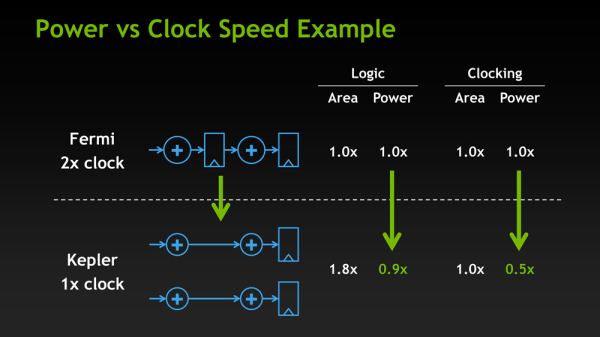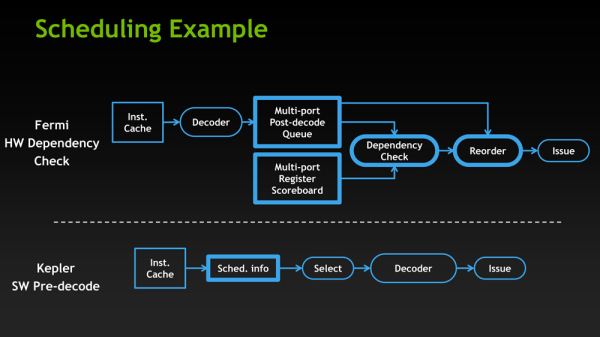NVIDIA GeForce GTX 680 Review: Retaking The Performance Crown
by Ryan Smith on March 22, 2012 9:00 AM ESTThe Kepler Architecture: Efficiency & Scheduling
So far we’ve covered how NVIDIA has improved upon Fermi for; now let’s talk about why.
Mentioned quickly in our introduction, NVIDIA’s big push with Kepler is efficiency. Of course Kepler needs to be faster (it always needs to be faster), but at the same time the market is making a gradual shift towards higher efficiency products. On the desktop side of matters GPUs have more or less reached their limits as far as total power consumption goes, while in the mobile space products such as Ultrabooks demand GPUs that can match the low power consumption and heat dissipation levels these devices were built around. And while strictly speaking NVIDIA’s GPUs haven’t been inefficient, AMD has held an edge on performance per mm2 for quite some time, so there’s clear room for improvement.
In keeping with that ideal, for Kepler NVIDIA has chosen to focus on ways they can improve Fermi’s efficiency. As NVIDIA's VP of GPU Engineering, Jonah Alben puts it, “[we’ve] already built it, now let's build it better.”
There are numerous small changes in Kepler that reflect that goal, but of course the biggest change there was the removal of the shader clock in favor of wider functional units in order to execute a whole warp over a single clock cycle. The rationale for which is actually rather straightforward: a shader clock made sense when clockspeeds were low and die space was at a premium, but now with increasingly small fabrication processes this has flipped. As we have become familiar with in the CPU space over the last decade, higher clockspeeds become increasingly expensive until you reach a point where they’re too expensive – a point where just distributing that clock takes a fair bit of power on its own, not to mention the difficulty and expense of building functional units that will operate at those speeds.
With Kepler the cost of having a shader clock has finally become too much, leading NVIDIA to make the shift to a single clock. By NVIDIA’s own numbers, Kepler’s design shift saves power even if NVIDIA has to operate functional units that are twice as large. 2 Kepler CUDA cores consume 90% of the power of a single Fermi CUDA core, while the reduction in power consumption for the clock itself is far more dramatic, with clock power consumption having been reduced by 50%.
Of course as NVIDIA’s own slide clearly points out, this is a true tradeoff. NVIDIA gains on power efficiency, but they lose on area efficiency as 2 Kepler CUDA cores take up more space than a single Fermi CUDA core even though the individual Kepler CUDA cores are smaller. So how did NVIDIA pay for their new die size penalty?
Obviously 28nm plays a significant part of that, but even then the reduction in feature size from moving to TSMC’s 28nm process is less than 50%; this isn’t enough to pack 1536 CUDA cores into less space than what previously held 384. As it turns out not only did NVIDIA need to work on power efficiency to make Kepler work, but they needed to work on area efficiency. There are a few small design choices that save space, such as using 8 SMXes instead of 16 smaller SMXes, but along with dropping the shader clock NVIDIA made one other change to improve both power and area efficiency: scheduling.
GF114, owing to its heritage as a compute GPU, had a rather complex scheduler. Fermi GPUs not only did basic scheduling in hardware such as register scoreboarding (keeping track of warps waiting on memory accesses and other long latency operations) and choosing the next warp from the pool to execute, but Fermi was also responsible for scheduling instructions within the warps themselves. While hardware scheduling of this nature is not difficult, it is relatively expensive on both a power and area efficiency basis as it requires implementing a complex hardware block to do dependency checking and prevent other types of data hazards. And since GK104 was to have 32 of these complex hardware schedulers, the scheduling system was reevaluated based on area and power efficiency, and eventually stripped down.
The end result is an interesting one, if only because by conventional standards it’s going in reverse. With GK104 NVIDIA is going back to static scheduling. Traditionally, processors have started with static scheduling and then moved to hardware scheduling as both software and hardware complexity has increased. Hardware instruction scheduling allows the processor to schedule instructions in the most efficient manner in real time as conditions permit, as opposed to strictly following the order of the code itself regardless of the code’s efficiency. This in turn improves the performance of the processor.
However based on their own internal research and simulations, in their search for efficiency NVIDIA found that hardware scheduling was consuming a fair bit of power and area for few benefits. In particular, since Kepler’s math pipeline has a fixed latency, hardware scheduling of the instruction inside of a warp was redundant since the compiler already knew the latency of each math instruction it issued. So NVIDIA has replaced Fermi’s complex scheduler with a far simpler scheduler that still uses scoreboarding and other methods for inter-warp scheduling, but moves the scheduling of instructions in a warp into NVIDIA’s compiler. In essence it’s a return to static scheduling.
Ultimately it remains to be seen just what the impact of this move will be. Hardware scheduling makes all the sense in the world for complex compute applications, which is a big reason why Fermi had hardware scheduling in the first place, and for that matter why AMD moved to hardware scheduling with GCN. At the same time however when it comes to graphics workloads even complex shader programs are simple relative to complex compute applications, so it’s not at all clear that this will have a significant impact on graphics performance, and indeed if it did have a significant impact on graphics performance we can’t imagine NVIDIA would go this way.
What is clear at this time though is that NVIDIA is pitching GTX 680 specifically for consumer graphics while downplaying compute, which says a lot right there. Given their call for efficiency and how some of Fermi’s compute capabilities were already stripped for GF114, this does read like an attempt to further strip compute capabilities from their consumer GPUs in order to boost efficiency. Amusingly, whereas AMD seems to have moved closer to Fermi with GCN by adding compute performance, NVIDIA seems to have moved closer to Cayman with Kepler by taking it away.
With that said, in discussing Kepler with NVIDIA’s Jonah Alben, one thing that was made clear is that NVIDIA does consider this the better way to go. They’re pleased with the performance and efficiency they’re getting out of software scheduling, going so far to say that had they known what they know now about software versus hardware scheduling, they would have done Fermi differently. But whether this only applies to consumer GPUs or if it will apply to Big Kepler too remains to be seen.












404 Comments
View All Comments
SlyNine - Sunday, March 25, 2012 - link
Well, the driver themself can take more CPU power to run. But with a quad core CPU the thought is laughable. Back in the single CPU/core days it was actually an issue. And before DX9 (or 10) Drivers were only capable of accessing single cores I believe.SlyNine - Sunday, March 25, 2012 - link
Then look for an overclocked review. Anandtech is always going to do an out of the box for the first review.This is what they(amd/nvidia) are promising you, nothing more.
papapapapapapapababy - Monday, March 26, 2012 - link
USELESS !YESSS OMFG i cant wait to play the latest crappy kinect port with this!.... at 600.000.000 FPS and in 3-D! GTFO GUYS! REALLY....
just put this ridiculously large, ugly, noisy, silly, and overpriced, toxic waste where it belongs: faaar away from me, ( sensible user) inside one bulky OnLive cloud server. (and pushing avatar 2 graphics, no HDps2 ports)
henrikfm - Monday, March 26, 2012 - link
Most monitors have 60Hz refresh rate, you can't benefit from higher frame rates because only 60 frames are drawn.By looking at the benchmarks and considering a resolution of 1920, the latest cards fail in 3 games to deliver at least 60fps: Crysis, Metro and BF3. In the first two games the HD7970 beats de GTX680, only loses in BF3 where nVidia has a clear advantage (in my opinion AMD has to work in drivers for BF3).
So, the GTX680 is faster when the speed really doesn't matter because you're already around 100fps. The guys who are running multiple monitors and higher resolutions will have also money to buy multiple GPU setups, and that is another story.
Still the GTX680 is a better card, but for $500 I would expect a card to deliver at least 60fps at 1920 for a 2008 released videogame like Crysis. Neither nVidia nor AMD can do that with a single GPU, it's disappointing.
gramboh - Monday, March 26, 2012 - link
I'll agree about Metro because there is a sequel (Last Light) coming out in Q1-2013 which will presumably be similar in the graphics department.Crysis is irrelevant other than for benchmarking, who still plays it? Single player campaign is entertaining for the eye candy once through (in 2008).
BF3 is the game that matters because of the MP component, people will be playing it for years to come. AMD really really has to improve performance on the 7950/7970 in BF3, I won't even consider buying it (vs. the 680) unless they can make up some significant ground.
CeriseCogburn - Tuesday, March 27, 2012 - link
I just have to do it, sorry.You forgot Shogun 2 total war, the hardest game in this bench set, that Nvidia wins in all 3 resolutions.
You also forgot average frames are not low frames, so you need far above 60 fps average before you don't dip below 60 fps.
Furthermore, all the eye candy is not cranked, driving the average and dips even lower when it is.
You got nothing right.
b3nzint - Monday, March 26, 2012 - link
back in 7970 review, its got cool stuffs tech. like PRT, MST hubm, DDMA and bla bla bla. why gtx680 dont have sh** like that. pardon my english. its like this thing is built only for 1 purpose only and thats a success. thanksmpx - Monday, March 26, 2012 - link
This new Nvidia card supposedly has an architecture that burdens CPU with scheduling etc. It may mean that it requires a faster CPU than ATI cards to reach similar performance. And since fast CPUs are expansive it may mean it's actually more expansive.BoFox - Monday, March 26, 2012 - link
The key word in your first sentence is "supposedly".I see no evidence of this. It actually does far better in Starcraft 2, a game that already burdens the CPU. It also excels in Skyrim, while still doing just fine in Civilization V, which are also the most CPU-intensive games out there.
BoFox - Monday, March 26, 2012 - link
In SC2 which is a very CPU-dependent game, the card still does amazingly well against the rest of others. The same also goes for Skyrim, beating the red team by a whopping percentage.